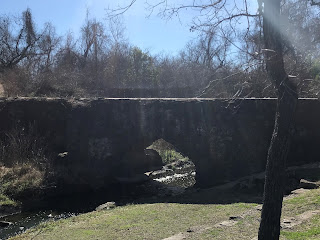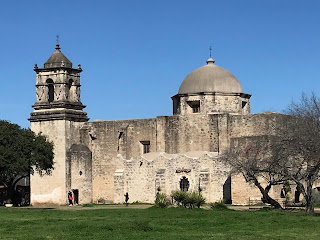Of course, the central piece of the mission is the church. And, once again, I could not take pictures of the interior because, alas, another funeral happened today. Here is the outside.
The missions were run by the Franciscan order of missionaries. They tried to convert the native tribes that were here (there were over 30); they taught them Spanish and Latin and how to build, etc. The buildings were built by the natives. This is what it would have looked like back in the day.
Next up was
It is an active church; a priest comes every Sunday for mass. This site had a lot of displays and information about the missions; so much so that I took pictures to explain the water/irrigation and their crops and sustainability of cows, sheep, and wool.
On the way through to the different missions, you pass the aqueduct, still in use today. What's amazing is Roman technology came into play in the 1700s. Go figure! And you didn't think you needed to learn this in school??!!
Next on the trail was
This one had a little more buildings to it and a 20 minute video that explained all about the missions and what happened during the 1700s and this area. The missions were only here for about 82 years. There is also a visitors center and a gift shop where I bought my sticker to put in my national parks passport (see, RS, I'm using it)!!
This is called a Rose Window. You'll have to Google why it's called that. There are many reasons.
Last in line was
This is the Jewel of the Crown, I think. It has the original colors of paint, the most well-preserved of all the missions. The priest gave us a good 15 minute run down and history of the missions, better than any video!
If you notice, too, the other missions had walls around them. These were to defend themselves against the Lupin Apache who roamed this area. The Mission Concepción had walls, but by then the threat was gone; so the locals used the stone to build their houses. The Spanish brought over some families from the Canary Islands to help colonize this area, too. They formed a new kind of people, called Tejanos. You will only find them in this area of Texas. So basically the tribes that lived here so long ago still live here today as the Tejanos.
All of the buildings are built out of limestone, which is quarried here locally. There is a natural cave of limestone near here that we visited. I will post on that another day. Tomorrow we visit the panhandle to another beautiful area. Ya'll come back! 😉
































No comments:
Post a Comment